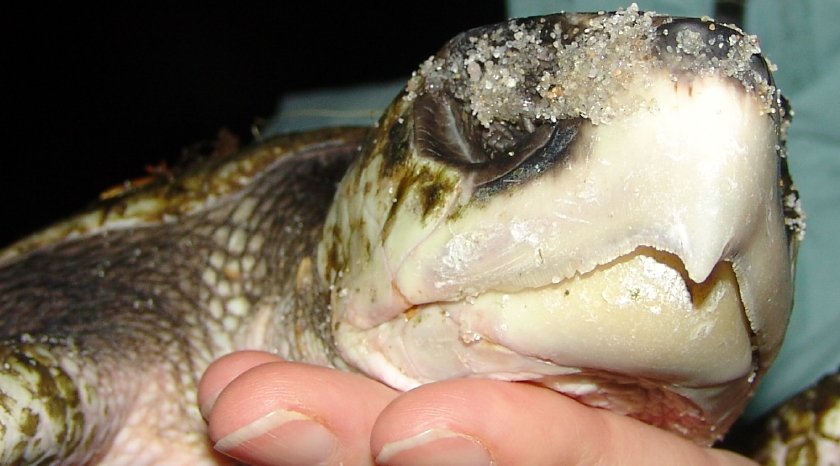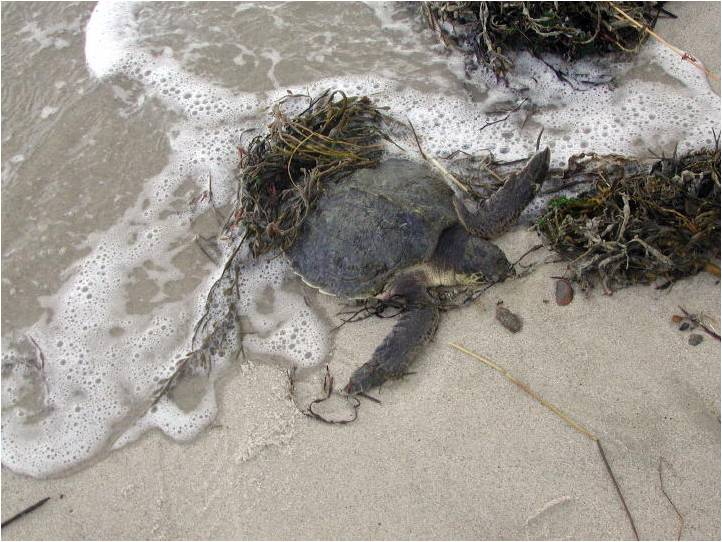Five Endangered Kemp’s Ridleys and One Threatened Green Sea Turtle Saved

Critically Endangered Kemp’s Ridley Juvenile Sea Turtle
“A night not fit for man nor beast,” as W.C. Fields might say, with winds howling from the west-northwest at a steady 25-to-30 knots, punctuated by an occasional 50 mph gust. Unfortunately, these are the very conditions in which tropical sea turtles strand each fall on bayside beaches. Trapped by the geological seine called Cape Cod jutting forty miles into the North Atlantic, tropical sea turtles become cold-stunned as bay water temperatures plunge below 50º F. By an accident of their natural lifecycle, most of these trapped and cold-stunned turtles are two and three year old Kemp’s ridleys, a critically endangered species and one of the rarest sea turtles in the world. So, on this night not fit for human or reptile, turtles would be tossed ashore like flotsam and jetsam, condemned to certain hypothermic death unless rescued from the beach by a dedicated team of staff and volunteers from Mass Audubon’s Wellfleet Bay Wildlife Sanctuary.
Â
Bob Prescott, sanctuary director, and Dennis Murley, senior naturalist, watch wind and weather conditions throughout the day to best deploy rescuers for night patrols. What during daylight seems a “walk on the beach” transforms at night into a dangerous obstacle course exacerbated by blinding darkness, pounding surf, scouring sandblasts and deafening winds. “Don’t attempt this on your own. Leave it to the pros.”

Sue Wieber Nourse and Jared Nourse Rescue 10-Inch Ridley
This Saturday night, they decided to send out patrols to bayside beaches from Eastham through Orleans and Brewster to Dennis; that is, beaches in the reciprocal direction of the prevailing wind. The Turtle Journal team drew the westernmost stretch from Chapin Beach to Sea Street in Dennis. As rescue nights go, this one rated a 10 with a waxing gibbous moon on high and the Constellation Orion rising in the eastern sky. Heck, it wasn’t snowing; not even raining!

Cold-Stunned Kemp’s Ridley Rescued from Chapin Beach
About a quarter mile east of the Chapin Beach ramp, the Turtle Journal team of Sue Wieber Nourse (senior partner, Cape Cod Consultants) and Jared Nourse (Williams College) found a juvenile Kemp’s ridley sea turtle rolling in the waves.  Measuring a mere 10-inch carapace (top shell) length, the turtle was tossed upside down on the beach. “It looked just like salty brine foam in the moonlight,” observed Ms. Nourse. She plucked the turtle from receding waves before it was pulled back out to sea and examined it carefully. She pronounced it “quite lively.”

Rescued Ridley and Wind-Teared Sue Wieber Nourse
Since Sue had to walk the animal back into the teeth of the WNW blow, she placed the little turtle under her top coat to protect it from the hypothermic effect of the blasting wind. So, back at the Turtle Journal research vehicle, the protected ridley was doing just fine (thank you) while Sue’s exposed eyes were tearing in the relentless wind.

Juvenile Kemp’s Ridley Measures 25.5Â Cm Carapace LengthÂ
The Turtle Journal team searched six more miles of coastline, but found no other cold-stunned turtle in Dennis. In Brewster, Dennis Murley and Mark Faherty recovered one Kemp’s ridley each. Bob Prescott hit the jackpot with one Kemp’s ridley from Boat Meadow in Eastham, plus one Kemp’s ridley and one good-sized green sea turtle from Skaket Beach in Orleans. All told, Mass Audubon rescuers had saved six cold-stunned sea turtles; five critically endangered Kemp’s ridleys and one threatened green sea turtle.

Cold-Stunned Kemp’s Ridley Strands with High Tide
“How Can I Help Save Stranded Sea Turtles?”
Â
If you encounter a sea turtle on the beach, first DO NOT put it back into the water. Doing so will condemn the animal to almost certain death. DO NOT remove the animal from the beach. A special license is required to transport federally protected species. Instead, DO move the turtle above the high water line. DO cover the animal with dry seaweed to prevent the wind from causing additional hypothermia. DO mark the covered turtle with a gaudy piece of flotsam or jetsam, perhaps a buoy or anything unusual … so that rescuers can easily find the critter hidden under a pile of seaweed. DO call Mass Audubon’s Wellfleet Bay Wildlife Sanctuary at (508) 349-2615 to report the turtle. If there is difficulty getting through to this number, you can always reach the Turtle Journal team at our 24/7 hotline (508-274-5108). When giving directions from the landing or beach to the turtle, DO use left and right (when facing the water) rather than cardinal directions. DO give the walking time it takes to reach the turtle from the landing (turn right and walk five minutes) rather than describing distance in feet, yards or fractions of miles.
Â
Thank you for helping save these rare and beautiful creatures. If you’d like to volunteer to patrol beaches during the day or drive rescued animals to Boston for medical care, contact Cynthia Franklin (cfranklin@massaudubon.org), volunteer coordinator at the Wellfleet Bay Wildlife Sanctuary (508-349-2615).
This entry was posted on Sunday, November 29th, 2009 at 3:15 pm and is filed under Turtles. You can follow any responses to this entry through the RSS 2.0 feed.
Both comments and pings are currently closed.





